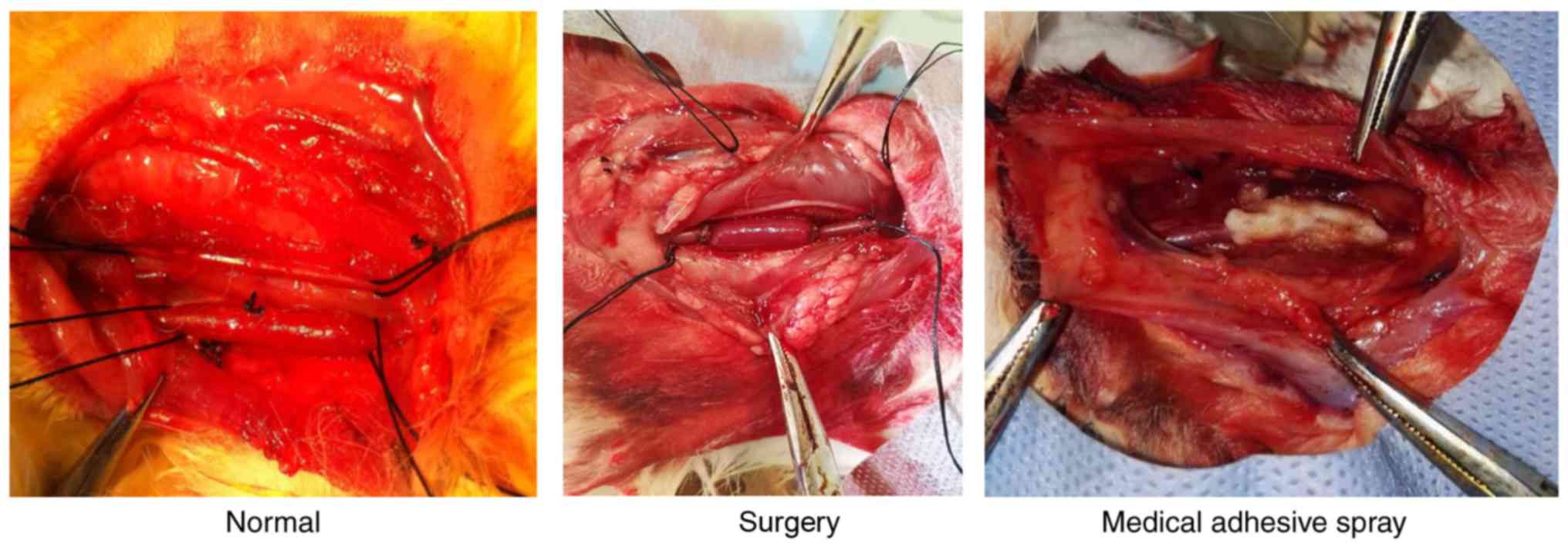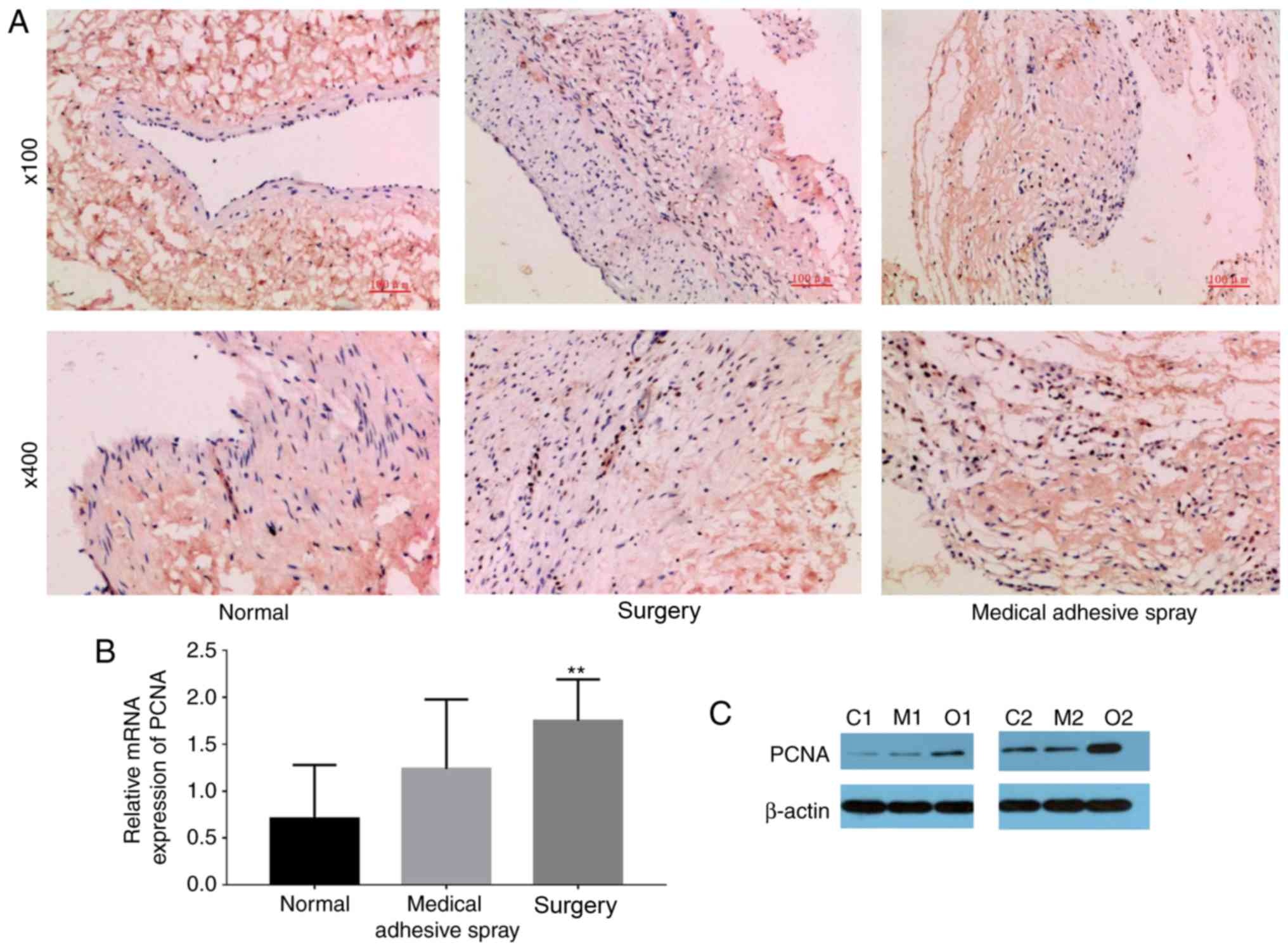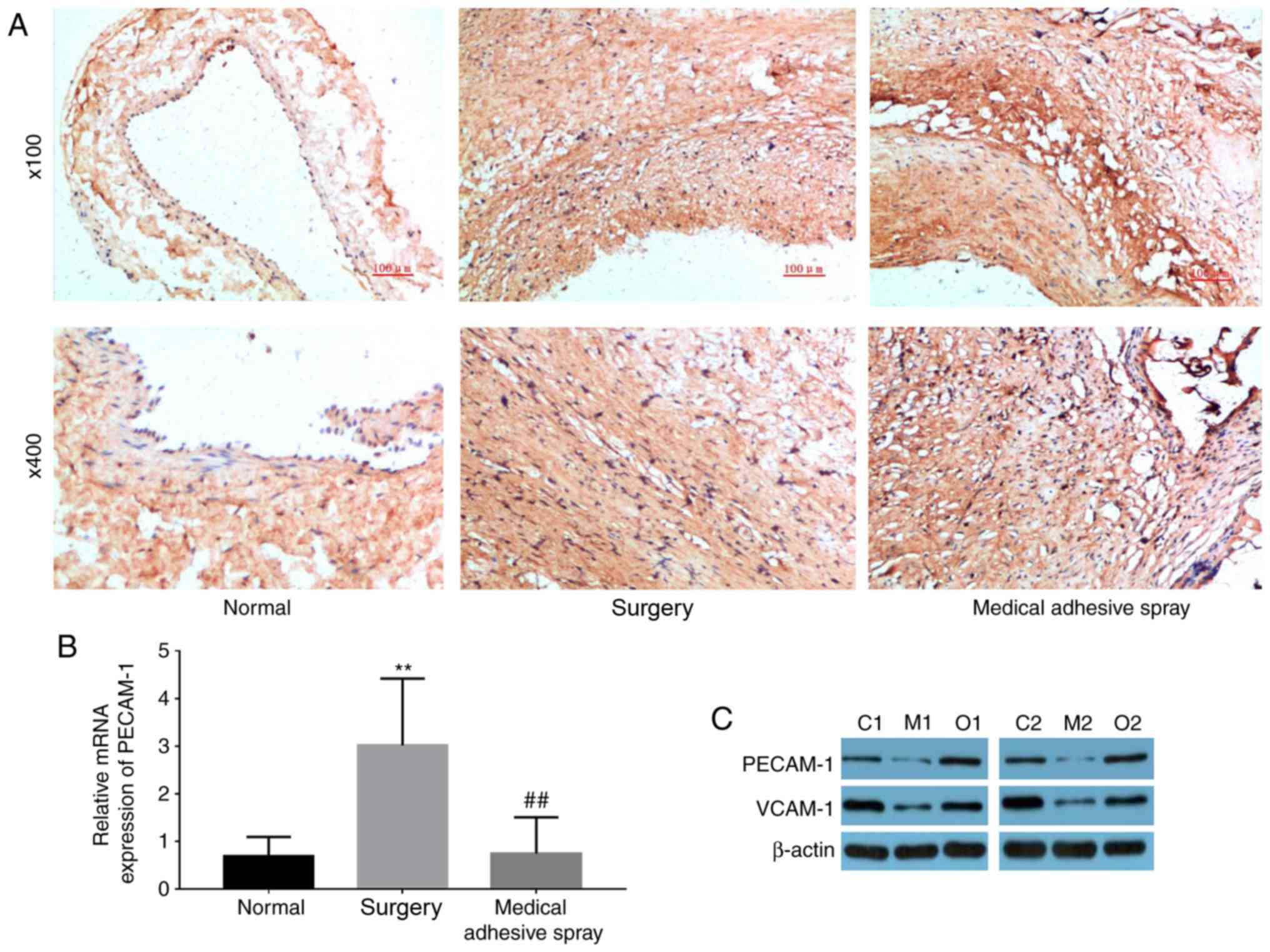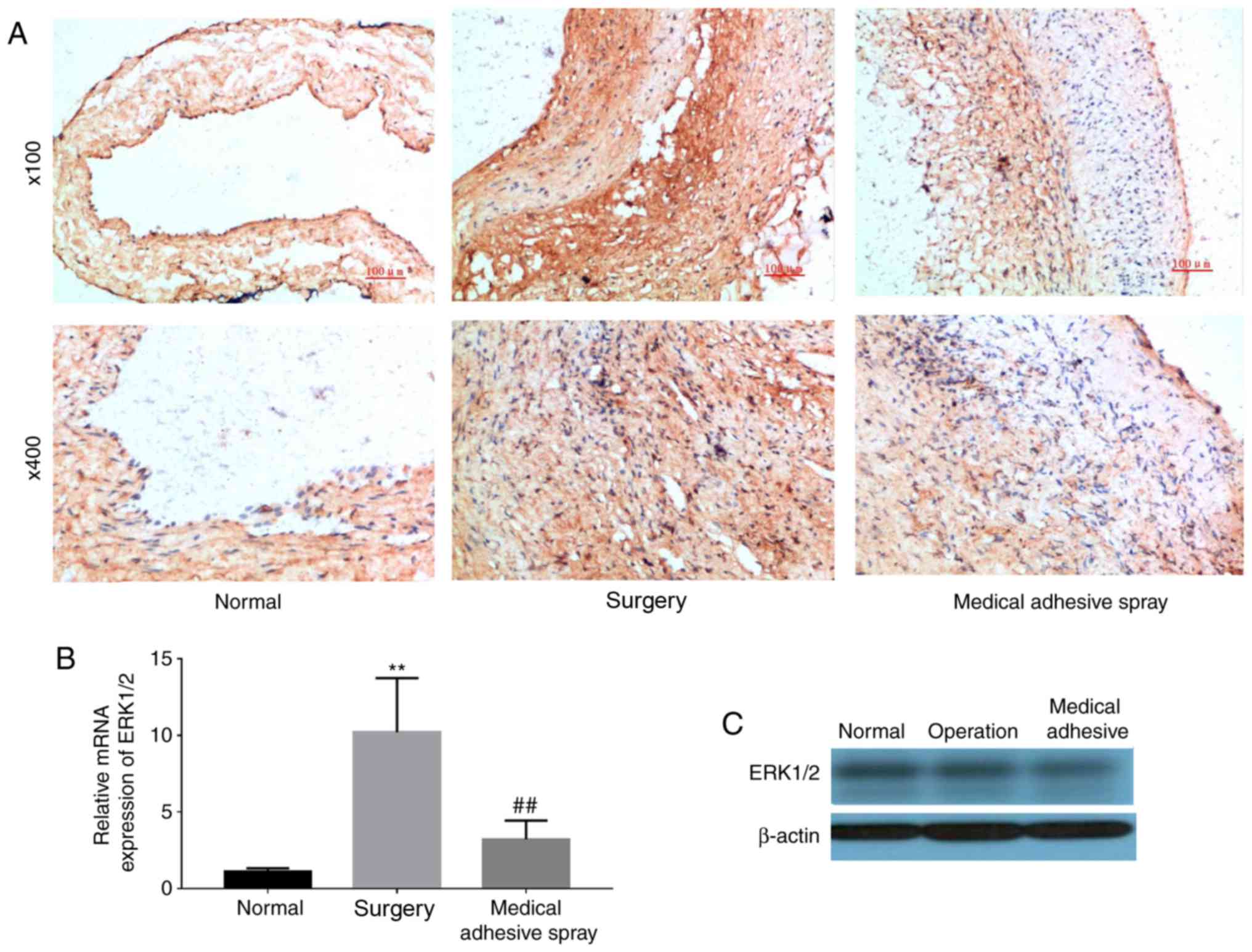Application of medical adhesive inhibits intimal hyperplasia involving the downregulation of ERK1/2 and eNOS levels
- Authors:
- Published online on: September 17, 2018 https://doi.org/10.3892/mmr.2018.9492
- Pages: 4643-4649
Abstract
Introduction
Due to its easy access and sufficient length, the great saphenous vein remains widely used in coronary artery bypass surgery (1,2). However, the long-term effect of the vein graft is restricted by its decreased patency rate. The present study focused on the effect and molecular mechanism of medical cyanoacrylate glue on the long-term patency of rabbit vein grafts.
When vein grafts are transplanted into the arterial system, dilatation occurs under arterial pressure, which causes the vascular wall to stretch, triggering remodeling of the vascular wall. Once the vein bridge in the blood vessel dilates, the diameter of the artery and vein blood vessel is increased, which causes a further mismatch in the arteriovenous anastomosis. In addition, blood flow is disordered in the anastomosis and the venous vascular segment. When laminar blood flows through the blood vessels, the flow has a protective effect on the inner wall of the blood vessels. In disease, the abnormal and disordered blood flow leads to vascular endothelial cell damage and dysfunction (3–5). Mechanotransduction is involved in the cytokine release of sensitive cells and signaling activation by mechanical stress (6,7). The activated signaling pathway is transformed into a cellular chemical signaling, and eventually regulates the cellular functioning of the effector cells by altering gene and protein expression levels (8–10).
Platelet endothelial cell adhesion molecule 1 (PECAM-1) is a type of mechanosensor, which serves important roles in promoting the release and delivery of biological signals via the signaling pathways with which it interacts (11). Proliferating cell nuclear antigen (PCNA) is a marker for the assessment of cell proliferation (12,13). It was demonstrated that vascular cell adhesion protein 1 (VCAM-1), ERK1/2 and endothelial nitric oxide synthase (eNOS) expression has important roles in injured arteries (14–16). In the present study, 36 New Zealand white rabbits were divided into three groups at random, with 12 in each group: The first group received no surgery (normal group); one group was subjected to transplantation of the left external jugular vein to the ipsilateral common carotid artery (surgery group); the other was subjected to transplantation of left external jugular vein to the common carotid artery on the labial side followed by the application of medical adhesive spray (medical adhesive spray group). A total of 4 weeks post-surgery, vascular ultrasound was performed to measure blood vessel diameter and vessel blood flow velocity. For pathological examination, the vein graft was removed, the thickness and area of the intima and media of the vessel were measured based via images, and alterations in the expression of PCNA, PECAM-1, VCAM-1, extracellular signal-regulated kinase (ERK)1/2 and eNOS were detected by immunohistochemical staining, reverse transcription-quantitative polymerase chain reaction (RT-qPCR) analysis and western blotting.
Materials and methods
Animals
A total of 36 New Zealand white rabbits were randomly selected and divided into three groups, 12 rabbits/group. Rabbits were provided by Capital Medical University (Beijing, China). Of the three groups, one received no surgery (normal group), one received transplantation of the left external jugular vein to the ipsilateral common carotid artery (surgery group), and the other received the transplantation of the left external jugular vein to the common carotid artery on the labial side followed by medical adhesive spray (medical adhesive spray group) (Fig. 1). Animals were maintained at 22°C with 55% humidity on a standard 12 h light/dark cycle with food and water available ad libitum. Animal experiments were in accordance with the ethics standards of animal research. The present study was approved by the Animal Experiments and Experimental Animal Welfare Committee of Capital Medical University (approval no. AEEI-2015-144).
Establishment of the model of rabbit external jugular vein graft in the common carotid artery
The autologous vein graft model was established. The rabbits were treated with fasting and water for 4 h prior to the surgery, the ear edge vein channel was established, and 30 g/l amobarbital anesthesia was administered intravenously with 30 mg/kg concentration. Subsequently, rabbits were fixed in a supine position. Longitudinal incisions were made from the anterior median of the neck skin and 30–50 mm of the jugular vein was cut, washed and soaked in heparin saline. The right common carotid artery was dissociated, and an ear vein injection of 10 g/l heparin (1 ml/kg) as given. Carotid artery catheterization was performed and a Philips V24E monitor (Philips Medical Systems, Inc., Bothell, WA, USA) was used to monitor the mean arterial blood pressure. Following occlusion of the proximal and distal resection of the carotid artery, the appropriate vein length was cut and inverted. An 8-0 nylon monofilament line was used for end-to-end anastomosis with an 8–10 needle, followed by opening the ends of the artery clamps to exhaust. Once the patency of the vein bridge and a lack of bleeding was ensured, the suture incision was performed layer by layer. An ear margin vein injection of 10 g/l heparin (1 ml/kg) was subsequently administered to prevent thrombosis, and an injection of penicillin (800,000 units) was administered to prevent infection. On the same day as the surgery, or the following day, blood vessel specimens were examined using the Philips IU22 color Doppler ultrasonic detector (Philips Medical Systems, Inc.) to ensure the patency of the vein bridge. Images of blood flow were acquired via postoperative ultrasonic measurement. The rabbits were constantly fed for 4 weeks. Daily observations of the animals were made and the data recorded.
Specimen collection and immunohistochemical detection
Immunohistochemical examination, RT-qPCR analysis and western blotting were used to detect the expression of PCNA, PECAM-1, VCAM-1, ERK1/2 and eNOS in the vein bridge. A total of 4 weeks subsequent to surgery, 30 g/l amobarbital anesthesia was used to treat the animals. Following anesthesia, the average arterial pressure was detected via left carotid artery catheterization. The right vein graft was separated and the required graft tissue was rapidly cut. The external jugular vein graft bridges of the three groups of rabbits were fixed in 4% polyformaldehyde at 4°C for 1 h. Following dehydration and permeabilization with 0.01% Triton X-100, the sections were embedded in paraffin. The thickness was 4 µm. Following embedding in paraffin, sections were blocked with 1% bovine serum albumin (Invitrogen; Thermo Fisher Scientific, Inc., Waltham, MA, USA) at 20°C for 1 h and stained with hematoxylin-eosin at room temperature for 4 h. Sections were subsequently incubated with primary antibodies against PCNA (1:100; cat. no. ab29; Abcam, Cambridge, MA, USA), PECAM-1 (1:100; cat. no. ab28364; Abcam), VCAM-1 (1:100; cat. no. ab106777; Abcam), ERK1/2 (1:100; cat. no. ab196883; Abcam) at 20°C for 2 h, followed by incubation with horseradish peroxidase-conjugated goat anti-rabbit and anti-mouse secondary antibodies (1:500; cat. nos. S004 and S001, respectively; Beijing TDY Biotech Co., Ltd., Beijing, China) at room temperature for 1 h. Sections were sealed and observed by light microscopy at a magnification of ×100. Image analysis was performed using an Olympus BX50 microscope (Olympus Corporation, Tokyo, Japan). The microscope was used to observe the tissue sections, and Image Pro Plus software 6.0 (Media Cybernetics, Inc., Rockville, MD, USA) was used to perform image acquisition and image analysis. The alterations in average arterial pressure prior to and following surgery, and the thickness and area of the graft vein intima and media were detected.
The RT-qPCR analysis and western blotting were performed by previously described methods (9,17). The specific primer sequences for each gene, including the reference gene were (5′-3′): PCNA forward, GGACTTAGATGTTGAACAGCTTGG and reverse, TTCTCCACTGGCGGAAAACTT; PECAM-1 forward, AACCATGCCATGAAGCCAGTA and reverse, ACCGAGGACACTTCCACTTCTG; ERK1/2 forward, ATAAAAAACCCCGCCGAGA and reverse, CAGCCAACCAGCAAAATCCA; eNOS forward, CACCCAGCATCTACCCAGGA and reverse, AGGGCACGGGGTCTCCA; and β-actin forward, AAGTGCGACGTGGACATCCG and reverse, GGGCGGTGATCTCCTTCTGC. For western blot analysis, primary antibodies against PCNA (1:500; cat. no. ab29; Abcam), PECAM-1 (1:500; cat. no. ab28364; Abcam), VCAM-1 (1:500; cat. no. ab106777; Abcam), ERK1/2 (1:500; cat. no. ab196883; Abcam), eNOS (1:500; cat. no. YM3164; ImmunoWay Biotechnology Company, Plano, TX, USA) and β-actin (1:1,000; cat. no. ab8227; Abcam) were incubated with the blots overnight at 4°C, followed by incubation with horseradish peroxidase-conjugated goat anti-rabbit and anti-mouse secondary antibodies (1:1,000; cat. nos. S004 and S001, respectively; Beijing TDY Biotech Co., Ltd.) at room temperature for 1 h.
Statistical analysis
SPSS 21.0 statistical analysis software (IBM Corp., Armonk, NY, USA) was applied, using the Student's t-test for two independent groups or one-way analysis of variance followed by Tukey's post-hoc test. All data are expressed as mean ± standard deviation. P<0.05 was considered to indicate a statistically significant difference.
Results
Pathological examination of vein grafts
The results of the present study demonstrated that the graft vascular wall was thickened in the surgery group, although this was not apparent in the normal and medical adhesive spray groups, illustrating that medical adhesive spray led to a positive outcome in the patency of the rabbit vein graft (Fig. 2).
A total of 4 weeks post-surgery, the thickness and area of the intima and media of vessel were measured on formalin-fixed, paraffin wax-embedded pathological sections (Table I). Based on hematoxylin-eosin staining, it was observed that the graft intima was markedly thickened in the normal group (Table I). The lumen was narrowed, with the appearance of a large number of proliferated smooth muscle cells under the intima. The smooth muscle cells were in a disordered arrangement, presenting as the typical phenotype of secretory cells. Collagen fibers around the cell membrane were slightly thickened.
Table I.Alterations in thickness and area of the intima and media in the normal control, surgery and medical adhesive spray groups, as measured via hematoxylin-eosin staining images. |
In the medical adhesive spray group, the intimal thickening was weakened compared with that in the normal group. The intima was notably small compared with the normal group. There was no obvious thickening of the media (Table I).
The intimal thicknesses of the normal group and the medical adhesive spray group were 107.50±12.73 and 41.34±14.53 µm (P<0.01), respectively. Intimal areas were 1.031±0.043 and 0.533±0.022 µm2 (P<0.01), respectively. The thicknesses of the media of the vein graft in the normal group and the medical adhesive spray group were 115.04±15.42 and 103.38±11.13 mm (P>0.05), respectively. The areas of the media were 1.092±0.051 and 1.054±0.030 mm2 (P>0.05), respectively.
Medical adhesive spray inhibits the injury-induced expression of PCNA
In order to examine the proliferation characteristics of vascular intimal tissues, immunohistochemical staining was performed using the monoclonal antibody of PCNA to test the level of PCNA in vascular wall tissues.
It was observed that yellow-brown particles in the vascular endothelial cell nuclei were positive for PCNA staining (Fig. 3). The expression of PCNA was significantly increased in the surgery group compared with the normal and medical adhesive spray groups (P<0.01).
Medical adhesive spray inhibits the injury-induced expression of PECAM-1 and VCAM-1
PECAM-1 was primarily located at the connection between endothelial cells, and was stained dark brown (Fig. 4A). PECAM-1 and VCAM-1 were more highly expressed in the surgery groups compared with the normal group (P<0.01). However, the use of medical adhesive inhibited the increase in PECAM-1 and VCAM-1.
Medical adhesive spray inhibits the injury-induced expression of ERK1/2
The expression of ERK1/2 was additionally detected (Fig. 5). Similar to the expression of PECAM-1 and VCAM-1, ERK1/2 was more highly expressed in the surgery groups compared with the normal group (P<0.01). However, the use of medical adhesive inhibited the increase in ERK1/2.
Medical adhesive spray inhibits the injury-induced expression of eNOS
The expression of eNOS was additionally detected (Fig. 6). Similar to the expression of ERK1/2, eNOS was more highly expressed in the surgery groups compared with the normal group (P<0.01). However, the use of medical adhesive inhibited the increase in eNOS.
Discussion
The excessive proliferation of smooth muscle cells and migration toward the intima, in addition to the abnormal deposition of vascular wall interstitial cells, results in vascular remodeling, vascular wall thickening, atherosclerosis and stenosis of the lumen (6,7). This process has been defined as vein arterialization (3–5). The present study demonstrated that the thickening of the venous wall was primarily caused by the proliferation of smooth muscle, which occurred over 4 weeks. Following transplantation of the vascular graft into the arterial environment, the vascular expansion resulted in an increased mechanical force (mechanical expansion and traction) with increased arterial pressure, causing damage to endothelial cells and smooth muscle cells, and triggering the release of various growth factors.
PCNA is an acidic polypeptide only synthesized and expressed in proliferating cells, and is additionally termed cyclin. As the auxiliary protein of DNA polymerase δ, PCNA is an important factor during cell synthesis (18–20). The expression of PCNA has been demonstrated to be associated with cell proliferation, and it acts as an indicator of cell proliferation (19). The most important function of PCNA is that it acts as an auxiliary protein of DNA polymerase 6 during nucleic acid metabolism (21). PCNA is, therefore, essential for DNA synthesis. DNA synthesis is the key event of the cell proliferation cycle. PCNA is a cell proliferation marker antigen (22). In the cell cycle, the synthesis of PCNA is important for the entry of cells into the S phase from the G0 and G1 phases. PCNA expression has been demonstrated to be increased in the late stages of cell entry into the G1 phase, reaches its peak in the S phase, and decreases in the G2 and M phases (23). The results of the present study demonstrated that expression of PCNA was significantly increased in the surgery group compared with the normal and the medical adhesive spray groups, indicating that the medical adhesive inhibited cell proliferation following surgery.
The present study demonstrated that a stent may reduce tension injury to the vein graft wall in the arterial environment, prevent the continuous expansion of the vein graft at arterial pressure, and reduce mechanical damage to the vascular endothelial cells and smooth muscle cells. Medical adhesive has been further demonstrated to prevent the excessive expansion of vein grafts, accelerate the blood flow rate, and decrease leukocyte adhesion, fibrin deposition, and thrombus formation and platelet aggregation (3–5). It has been demonstrated that laminar shear stress inhibits the proliferation of endothelial cells through the induction of cell cycle dependent kinase inhibitors, although disordered fluid shear stress may remove this inhibition and consequently promote cell proliferation (24). ERK1/2 and eNOS are involved in the expansion of vascular wall (6,25). Medical adhesive spray may inhibit the expansion of the vascular wall via inhibition of the ERK1/2 and eNOS signaling pathways.
PECAM-1 and VCAM-1 are primarily distributed in blood cells and vascular endothelial cells. PECAM-1 and VCAM-1 are involved in the signal transduction of adhesion molecules, and may additionally regulate the function of endothelial cells (26,27). The cell-cell interactions between endothelial cells are the structural foundation for the maintenance of vascular integrity and the regulation of leukocyte infiltration, in addition to vascular permeability (28,29).
PECAM-1 belongs to a superfamily of immunoglobulin adhesion molecules. PECAM-1 is expressed in activated platelet membrane and vascular endothelial cells, and may induce the initial stages of inflammation and stimulate the migration of leukocytes by participating in the transition of extracellular signals to the intracellular environment (30). PECAM-1 is able to control the activity of platelets, regulate the migration of leukocytes to the vascular intima and maintain the integrity of the vessel wall. If endothelial cells are injured, their function is decreased, leading to adverse consequences (31,32). The results of the present study suggested that PECAM-1 and VCAM-1 may serve important roles in the regulation of endometrial hyperplasia by medical adhesive.
In conclusion, the application of medical adhesive significantly inhibited intimal hyperplasia, which may be associated with restriction of the over-distension of the vein graft by downregulating the ERK1/2 and eNOS levels, reducing the injury to the vascular intima and inhibiting the signaling pathways involved in intimal hyperplasia. However, the exact mechanism underlying the role of medical adhesive in the inhibition of intimal hyperplasia requires further investigation.
Acknowledgements
Not applicable.
Funding
No funding was received.
Availability of data and materials
The datasets used and/or analyzed during the current study are available from the corresponding author on reasonable request.
Author's contributions
SC and CG conceived and designed the experiments. SC, YY, HL, MG and LB performed the experiments. SC produced the manuscript. SC and YY conducted data analysis.
Ethics approval and consent to participate
The present study was approved by the Animal Experiments and Experimental Animal Welfare Committee of Capital Medical University (approval no. AEEI-2015-144).
Consent for publication
Not applicable.
Competing interests
The authors declare that they have no competing interests.
References
|
Shoab SS, Lowry D and Tiwari A: Effect of treated length in endovenous laser ablation of great saphenous vein on early outcomes. J Vasc Surg Venous Lymphat Disord. 4:416–421. 2016. View Article : Google Scholar : PubMed/NCBI | |
|
Fattoum M, Kennel S, Knez P, Schmitz-Rixen T, Khout H and Tenholt MH: Lower extremity arterial revascularization using conditioned small-diameter great saphenous vein. J Vasc Surg. 64:819–823. 2016. View Article : Google Scholar : PubMed/NCBI | |
|
Lehoux S and Jones EA: Shear stress, arterial identity and atherosclerosis. Thromb Haemost. 115:467–473. 2016. View Article : Google Scholar : PubMed/NCBI | |
|
Heo KS, Fujiwara K and Abe J: Shear stress and atherosclerosis. Mol Cells. 37:435–440. 2014. View Article : Google Scholar : PubMed/NCBI | |
|
Cunningham KS and Gotlieb AI: The role of shear stress in the pathogenesis of atherosclerosis. Lab Invest. 85:9–23. 2005. View Article : Google Scholar : PubMed/NCBI | |
|
Zeng Y and Liu J: Role of glypican-1 in endothelial NOS activation under various steady shear stress magnitudes. Exp Cell Res. 348:184–189. 2016. View Article : Google Scholar : PubMed/NCBI | |
|
Zeng Y, Waters M, Andrews A, Honarmandi P, Ebong EE, Rizzo V and Tarbell JM: Fluid shear stress induces the clustering of heparan sulfate via mobility of glypican-1 in lipid rafts. Am J Physiol Heart Circ Physiol. 305:H811–H820. 2013. View Article : Google Scholar : PubMed/NCBI | |
|
Dunn J, Simmons R, Thabet S and Jo H: The role of epigenetics in the endothelial cell shear stress response and atherosclerosis. Int J Biochem Cell Biol. 67:167–176. 2015. View Article : Google Scholar : PubMed/NCBI | |
|
Liu JX, Yan ZP, Zhang YY, Wu J, Liu XH and Zeng Y: Hemodynamic shear stress regulates the transcriptional expression of heparan sulfate proteoglycans in human umbilical vein endothelial cell. Cell Mol Biol (Noisy-le-grand). 62:1–34. 2016. | |
|
Nigro P, Abe J and Berk BC: Flow shear stress and atherosclerosis: A matter of site specificity. Antioxid Redox Signal. 15:1405–1414. 2011. View Article : Google Scholar : PubMed/NCBI | |
|
Vogel V: Mechanotransduction involving multimodular proteins: Converting force into biochemical signals. Annu Rev Biophys Biomol Struct. 35:459–488. 2006. View Article : Google Scholar : PubMed/NCBI | |
|
Boehm EM, Powers KT, Kondratick CM, Spies M, Houtman JC and Washington MT: The proliferating cell nuclear antigen (PCNA)-interacting protein (PIP) motif of DNA polymerase eta mediates its interaction with the C-terminal domain of Rev1. J Biol Chem. 291:8735–8744. 2016. View Article : Google Scholar : PubMed/NCBI | |
|
MacNeill SA: PCNA-binding proteins in the archaea: Novel functionality beyond the conserved core. Curr Genet. 62:527–532. 2016. View Article : Google Scholar : PubMed/NCBI | |
|
Krejcy K, Schwarzacher S, Ferber W, Plesch C, Cybulsky MI and Weidinger FF: Expression of VCAM-1 in rabbit iliac arteries is associated with vasodilator dysfunction of regenerated endothelium following balloon injury. Atherosclerosis. 122:59–67. 1996. View Article : Google Scholar : PubMed/NCBI | |
|
Liu D, Ding Z, Wu M, Xu W, Qian M, Du Q, Zhang L, Cui Y, Zheng J, Chang H, et al: The apolipoprotein A-I mimetic peptide, D-4F, alleviates ox-LDL-induced oxidative stress and promotes endothelial repair through the eNOS/HO-1 pathway. J Mol Cell Cardiol. 105:77–88. 2017. View Article : Google Scholar : PubMed/NCBI | |
|
Zhou J, Chen L, Fan Y, Jiang J and Wan J: Atorvastatin increases endothelial progenitor cells in balloon-injured mouse carotid artery. Can J Physiol Pharmacol. 92:369–374. 2014. View Article : Google Scholar : PubMed/NCBI | |
|
Zeng Y, Yao X, Chen L, Yan Z, Liu J, Zhang Y, Feng T, Wu J and Liu X: Sphingosine-1-phosphate induced epithelial-mesenchymal transition of hepatocellular carcinoma via an MMP-7/syndecan-1/TGF-β autocrine loop. Oncotarget. 7:63324–63337. 2016. View Article : Google Scholar : PubMed/NCBI | |
|
Kawasoe Y, Tsurimoto T, Nakagawa T, Masukata H and Takahashi TS: MutSalpha maintains the mismatch repair capability by inhibiting PCNA unloading. Elife. 5:e151552016. View Article : Google Scholar : PubMed/NCBI | |
|
Juríková M, Danihel L', Polák Š and Varga I: Ki67, PCNA, and MCM proteins: Markers of proliferation in the diagnosis of breast cancer. Acta Histochem. 118:544–552. 2016. View Article : Google Scholar : PubMed/NCBI | |
|
Huang F, Abmayr SM and Workman JL: Limiting PCNA-unloading at the G1/S transition. Cell Cycle. 153001–3002. 2016. | |
|
Boehm EM, Spies M and Washington MT: PCNA tool belts and polymerase bridges form during translesion synthesis. Nucleic Acids Res. 44:8250–8260. 2016. View Article : Google Scholar : PubMed/NCBI | |
|
Álvarez V, Viñas L, Gallego-Sánchez A, Andrés S, Sacristán MP and Bueno A: Orderly progression through S-phase requires dynamic ubiquitylation and deubiquitylation of PCNA. Sci Rep. 6:255132016. View Article : Google Scholar : PubMed/NCBI | |
|
Yokoyama R, Hirakawa T, Hayashi S, Sakamoto T and Matsunaga S: Dynamics of plant DNA replication based on PCNA visualization. Sci Rep. 6:296572016. View Article : Google Scholar : PubMed/NCBI | |
|
Akimoto S, Mitsumata M, Sasaguri T and Yoshida Y: Laminar shear stress inhibits vascular endothelial cell proliferation by inducing cyclin-dependent kinase inhibitor p21(Sdi1/Cip1/Waf1). Circ Res. 86:185–190. 2000. View Article : Google Scholar : PubMed/NCBI | |
|
Zhang Y, Liao B, Li M, Cheng M, Fu Y, Liu Q, Chen Q, Liu H, Fang Y, Zhang G and Yu F: Shear stress regulates endothelial cell function through SRB1-eNOS signaling pathway. Cardiovasc Ther. 34:308–313. 2016. View Article : Google Scholar : PubMed/NCBI | |
|
Feng YM, Chen XH and Zhang X: Roles of PECAM-1 in cell function and disease progression. Eur Rev Med Pharmacol Sci. 20:4082–4088. 2016.PubMed/NCBI | |
|
Paddock C, Zhou D, Lertkiatmongkol P, Newman PJ and Zhu J: Structural basis for PECAM-1 homophilic binding. Blood. 127:1052–1061. 2016. View Article : Google Scholar : PubMed/NCBI | |
|
Gu P, Theiss A, Han J and Feagins LA: Increased cell adhesion molecules, PECAM-1, ICAM-3, or VCAM-1, predict increased risk for flare in patients with quiescent inflammatory bowel disease. J Clin Gastroenterol. 51:522–527. 2017. View Article : Google Scholar : PubMed/NCBI | |
|
Jiang L, Lin L, Li R, Yuan C, Xu M, Huang JH and Huang M: Dimer conformation of soluble PECAM-1, an endothelial marker. Int J Biochem Cell Biol. 77:102–108. 2016. View Article : Google Scholar : PubMed/NCBI | |
|
Chistiakov DA, Orekhov AN and Bobryshev YV: Endothelial PECAM-1 and its function in vascular physiology and atherogenic pathology. Exp Mol Pathol. 100:409–415. 2016. View Article : Google Scholar : PubMed/NCBI | |
|
Wang Z, Lei L, Cai XJ, Chen LY, Yuan M, Yang G, Huang P and Wang X: A preliminary study of pamidronic acid downregulation of angiogenic factors IGF-1/PECAM-1 expression in circulating level in bone metastatic breast cancer patients. Onco Targets Ther. 9:3147–3152. 2016. View Article : Google Scholar : PubMed/NCBI | |
|
Lertkiatmongkol P, Paddock C, Newman DK, Zhu J, Thomas MJ and Newman PJ: The role of sialylated glycans in human PECAM-1-mediated trans-homophilic interactions and endothelial cell barrier function. J Biol Chem. 291:26216–26225. 2016. View Article : Google Scholar : PubMed/NCBI |















